Crafting can be an excellent therapeutic activity for seniors with dementia. It helps stimulate memory, improve hand-eye coordination, and provide a sense of accomplishment. The key is to keep the crafts simple, repetitive, and sensory-focused, ensuring they are enjoyable without being overwhelming.
Here’s a list of easy craft ideas tailored for seniors with dementia, along with step-by-step instructions for each.
1. No-Sew Fabric Pillows
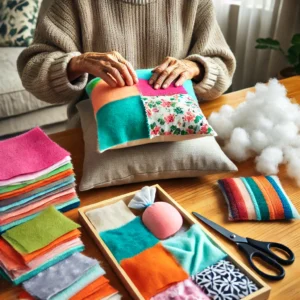
This craft involves soft fabrics, which can provide a soothing sensory experience for seniors. The simple tying technique is easy to follow and doesn’t require needles or sewing.
Materials Needed:
- Pre-cut fleece fabric squares (two per pillow, about 12×12 inches)
- Pillow stuffing
- Scissors
Steps:
- Prepare the fabric: Lay two fleece squares on top of each other, aligning the edges.
- Cut fringe: Cut 3-inch-long fringe strips (about 1 inch wide) along all four sides.
- Tie the strips: Tie the fringe strips from both layers together, leaving a small gap unknotted.
- Stuff the pillow: Insert pillow stuffing through the gap, then tie the remaining strips to close it.
Why It’s Great:
- Soft textures offer sensory comfort.
- Simple tying motions are repetitive and calming.
2. Simple Collage Art
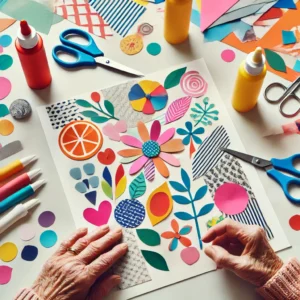
Collages are a great way to spark creativity without requiring precision. Seniors can explore colors, textures, and images in a relaxed setting.
Materials Needed:
- Old magazines or colored paper
- Glue sticks
- Blank cardstock or paper
- Scissors
Steps:
- Cut out shapes or pictures: Provide pre-cut magazine clippings or let seniors cut their own.
- Arrange on paper: Help seniors arrange the pieces on the blank cardstock.
- Glue down the pieces: Once they’re happy with the arrangement, assist them in gluing the pieces down.
Why It’s Great:
- No right or wrong way to create a collage.
- Encourages self-expression and can evoke positive memories.
3. Bead Stringing
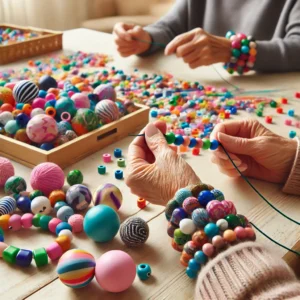
Stringing beads is an easy, repetitive craft that helps improve fine motor skills while being visually stimulating.
Materials Needed:
- Large, colorful beads (easy to handle)
- Thick elastic cord or string
- Scissors
Steps:
- Cut the string: Cut a length of cord that’s easy to handle.
- String the beads: Encourage seniors to string beads in any pattern they like.
- Tie off the ends: Once finished, tie the ends securely to make a bracelet or necklace.
Why It’s Great:
- The repetitive action is calming.
- Bright beads provide visual stimulation.
4. Tissue Paper Collage
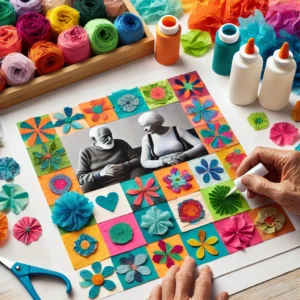
This craft is sensory-friendly and encourages creativity with soft, colorful tissue paper.
Materials Needed:
- Colored tissue paper (cut into small squares)
- Glue stick
- Blank cardstock or canvas
Steps:
- Apply glue: Spread glue on the blank cardstock or canvas.
- Add tissue paper: Encourage seniors to press the tissue paper squares onto the glue.
- Layer as desired: Let them overlap different colors for a beautiful, textured effect.
Why It’s Great:
- Soft tissue paper feels pleasant to touch.
- No precise cutting or arrangement is needed.
5. Decorating Flower Pots
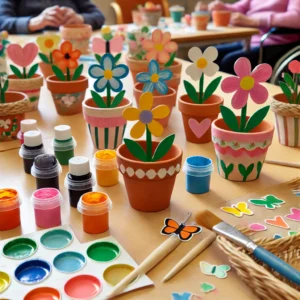
Simple decorating tasks like painting or gluing decorations on flower pots can be enjoyable and satisfying.
Materials Needed:
- Small terracotta pots
- Acrylic paint or foam stickers
- Paintbrushes
Steps:
- Paint or decorate: Help seniors paint the pots or apply foam stickers for decoration.
- Let it dry: Allow the decorated pots to dry completely.
- Use the pot: Fill the pot with artificial flowers or small plants.
Why It’s Great:
- Painting and decorating require simple motions.
- The finished pot can be used for display, providing a sense of accomplishment.
6. Paper Chain Garland
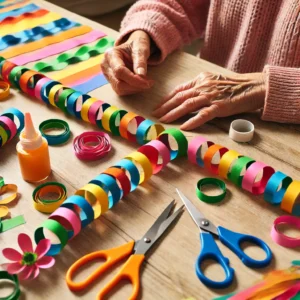
Creating a paper chain garland is an easy, repetitive craft that results in a bright and colorful decoration.
Materials Needed:
- Colored construction paper
- Scissors
- Glue stick or tape
Steps:
- Cut strips: Pre-cut strips of paper, or let seniors cut their own if they’re able.
- Make loops: Form a loop with one strip and glue or tape the ends together.
- Add more loops: Continue adding loops by threading strips through the previous loop and securing them.
Why It’s Great:
- Repetitive actions help with focus.
- Bright colors make it visually engaging.
7. Nature Collage
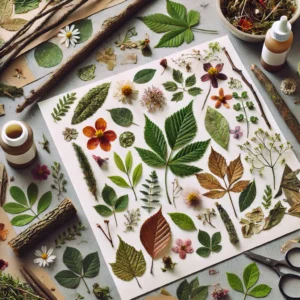
This craft involves gathering natural materials and arranging them into a collage, which can help spark memories of being outdoors.
Materials Needed:
- Leaves, flowers, small twigs, and other natural items
- Blank cardstock or paper
- Glue stick
Steps:
- Gather materials: Take a short walk with seniors to gather leaves and small flowers.
- Arrange on paper: Help seniors arrange the materials on the cardstock.
- Glue in place: Once arranged, assist them in gluing the pieces down.
Why It’s Great:
- Combines light physical activity with creativity.
- Encourages reminiscing about nature and past outdoor experiences.
8. Decorating Picture Frames
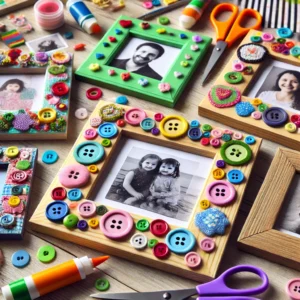
Personalized picture frames can be a meaningful craft, especially if they involve family photos.
Materials Needed:
- Plain wooden or cardboard picture frames
- Foam stickers, buttons, or pre-cut decorations
- Glue
Steps:
- Select decorations: Provide various decorations like foam stickers or buttons.
- Attach decorations: Help seniors glue the decorations onto the frame.
- Add a photo: Once the frame is dry, insert a family photo or a nature picture.
Why It’s Great:
- Provides a tangible way to connect with family memories.
- Easy to do with minimal steps.
Final Thoughts
Crafting for seniors with dementia is about more than just making something—it’s about offering them a calm, creative outlet that fosters positive emotions and provides sensory engagement. By choosing simple, repetitive, and tactile activities, you can ensure that crafting remains a joyful and stress-free experience for them.
Leave a Reply